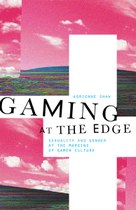Digital Culture & Education review: Gaming at the Edge
 Adrienne Shaw starts her book “Gaming at the Edge” with a childhood memory about everyday life in Japan. She recalls receiving a Nintendo console and a handful of games from her mother, which her friends and family enjoyed playing on for years. “Because of all this”, she concludes, “it never really occurred to me that gaming was something only a certain type of person did. In fact, it was only in my adult life that I heard people talking about the heterosexual, white, cisgendered male gamer as the norm” (vii).
Adrienne Shaw starts her book “Gaming at the Edge” with a childhood memory about everyday life in Japan. She recalls receiving a Nintendo console and a handful of games from her mother, which her friends and family enjoyed playing on for years. “Because of all this”, she concludes, “it never really occurred to me that gaming was something only a certain type of person did. In fact, it was only in my adult life that I heard people talking about the heterosexual, white, cisgendered male gamer as the norm” (vii).
As Shaw demonstrates in this vignette, marginalised game audiences have existed for as long as the video game market has ignored them. More than that, they are perfectly capable of enjoying play irrespective of whether games symbolically annihilate them or not. For those game professionals and theorists who have finally warmed to the idea that representing minorities matters, this observation might at first come as a shock. As a matter of fact, Shaw’s study calls into question the relevance of a game market custom-tailoring products to the needs of minorities. One of the central achievements of the book is its demonstration that such needs do not exist, at least not in a way that can be adequately catered to by a marketing logic.
By: Sabine Harrer
Story Date: 2015-07-17T05:00:00+00:00



